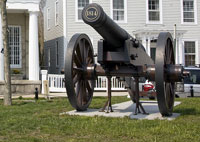 Yesterday, I went on a field trip with the New York Shiplore and Model Club to Stonington and Mystic, Connecticut. (Thanks to Lee Gruzen, Norman Brouwer and Linda Zatkowski for making the arrangements.) Our first stop was Stonington, Connecticut, a small village on the extreme eastern coast of the state. In the center of the village, two 18 pound cannon are on display in the fittingly named Cannon Square. On their tampions, blocking the ends of the cannon’s muzzles, is the date 1814, when the two cannons, manned by local militia, almost miraculously drove off a British force of four Royal Navy ships under the command of Captain Sir Thomas Hardy, Nelson’s flag captain on HMS Victory at the Battle of Trafalgar. The battle may not have been of any great strategic importance, but was one of a series of American victories in the last days of the War of 1812.
Yesterday, I went on a field trip with the New York Shiplore and Model Club to Stonington and Mystic, Connecticut. (Thanks to Lee Gruzen, Norman Brouwer and Linda Zatkowski for making the arrangements.) Our first stop was Stonington, Connecticut, a small village on the extreme eastern coast of the state. In the center of the village, two 18 pound cannon are on display in the fittingly named Cannon Square. On their tampions, blocking the ends of the cannon’s muzzles, is the date 1814, when the two cannons, manned by local militia, almost miraculously drove off a British force of four Royal Navy ships under the command of Captain Sir Thomas Hardy, Nelson’s flag captain on HMS Victory at the Battle of Trafalgar. The battle may not have been of any great strategic importance, but was one of a series of American victories in the last days of the War of 1812.
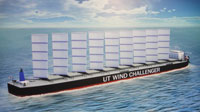 Early airplane wings were built of canvas stretched over a wooden frame, held together with wire rigging. Modern airplane wings are built of aluminum and other metals. The comparison to sails, masts and rigging on ships may not apply directly. Nevertheless, the last America’s Cup winner, the US-17, formerly known as the BMW Oracle Racing 90, screamed to victory in 2010, sailing on a 223 feet rigid wing sail, more than 80 percent larger than the wing of a Boeing 747 airplane. Now a Japanese group, including engineers from the University of Tokyo, are developing the design of a merchant ship with retracting rigid wing sails, the UT Wind Challenger.
Early airplane wings were built of canvas stretched over a wooden frame, held together with wire rigging. Modern airplane wings are built of aluminum and other metals. The comparison to sails, masts and rigging on ships may not apply directly. Nevertheless, the last America’s Cup winner, the US-17, formerly known as the BMW Oracle Racing 90, screamed to victory in 2010, sailing on a 223 feet rigid wing sail, more than 80 percent larger than the wing of a Boeing 747 airplane. Now a Japanese group, including engineers from the University of Tokyo, are developing the design of a merchant ship with retracting rigid wing sails, the UT Wind Challenger.
Ernest Borgnine has died at the age of 95. He joined the Navy in 1935, straight out of high school and served through World War II, leaving the service with the rank of gunner’s mate 1st class. He became an actor, appearing in over 140 movies and winning an Academy Award for Best Actor in 1955 for the movie, Marty. He is probably best known, however, for his role as Lt.Commander Quentin McHale in McHale’s Navy, a situation comedy about the insubordinate crew of a PT boat in the Pacific during World War II which ran from 1962-1966. Actor and comedian Tim Conway played his second in command in McHale’s Navy. More than thirty years later they would re-unite in 1999 when Borgnine voiced the role of the elderly superhero Mermaid Man in the cartoon SpongeBob SquarePants, where Tim Conway provided the voice of Mermaid Man’s sidekick, Barnacle Boy.
[iframe: width=”560″ height=”315″ frameborder=”0″ scrolling=”no” src=”http://www.washingtonpost.com/ernest-borgnine-dies-at-the-age-of-95/2012/07/09/gJQAYOKwXW_inline.html”]
Ernest Borgnine dies at 95; won Oscar for ‘Marty,’ showed comic side in sitcom
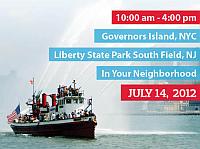 The City of New York is a city of islands, large and small, floating in a vast harbor and waterway. Only one of the five boroughs is on the mainland and that even borough, the Bronx, is on a peninsula, with water on three sides. The city and the metropolitan area of 20 million people only exist because of the harbor, the Hudson River estuary, and neighboring rivers and sounds. Once again the Metropolitan Waterfront Alliance is presenting “City of Water Day” to celebrate the mighty New York – New Jersey harbor and to witness the potential of the waterfront. The festivities will be held on Governors Island and Liberty State Park from 10:00 AM to 4:00PM on July 14th. Activities are also scheduled in Brooklyn, Manhattan, Staten Island, the Bronx and on the Jersey side of the Hudson River. Click here for details of local activities.
The City of New York is a city of islands, large and small, floating in a vast harbor and waterway. Only one of the five boroughs is on the mainland and that even borough, the Bronx, is on a peninsula, with water on three sides. The city and the metropolitan area of 20 million people only exist because of the harbor, the Hudson River estuary, and neighboring rivers and sounds. Once again the Metropolitan Waterfront Alliance is presenting “City of Water Day” to celebrate the mighty New York – New Jersey harbor and to witness the potential of the waterfront. The festivities will be held on Governors Island and Liberty State Park from 10:00 AM to 4:00PM on July 14th. Activities are also scheduled in Brooklyn, Manhattan, Staten Island, the Bronx and on the Jersey side of the Hudson River. Click here for details of local activities.
Last Friday, 19 schooners sailed from the starting line near the Breakwater Lighthouse in Rockland, Me out into Penobscott, Bay and then into Camden, Me, for the 36th annual Great Windjammer Race. After the breakneck speeds of America’s Cup catamarans, the stately pace of the old schooners is almost soothing. The race is sponsored yearly by the Maine Windjammer Association. Thanks to Irwin Bryan for passing along the article.
Great Windjammer Race: A perfect day on the bay
After fifteen years of work, the replica of the frigate L’Hermione was launched yesterday into the Charente River in Rochefort, France. The original frigate L’Hermione, on March 21, 1780, carried the the 23 year old Gilbert du Motier, better known as the Marquis de Lafayette, to America with the then secret news that France was committing 5,500 men and five frigates to help George Washington and his forces in the revolution against Great Britain.
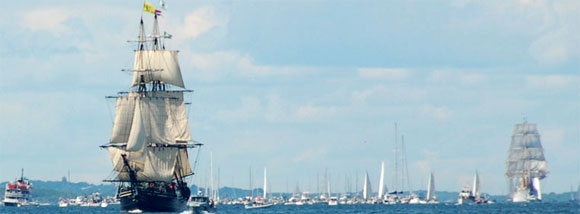 To say that this will be a busy weekend on the New England waterfront may be an understatement. Following the 4th of July festivities in Boston, OpSail 2012 CT starts today in New London, CT, with an impressive fleet of ships. Only about 50 miles away, the Ocean State Tall Ships Festival 2012 in Newport, Rhode Island, also starts today. The Newport festival also has an impressive fleet attending. Both festivals run today through Monday. Exactly why anyone though that it was a good idea to schedule two tall ship festivals on the same weekend, 50 miles apart is not clear. Fortunately either festival is a good choice.
To say that this will be a busy weekend on the New England waterfront may be an understatement. Following the 4th of July festivities in Boston, OpSail 2012 CT starts today in New London, CT, with an impressive fleet of ships. Only about 50 miles away, the Ocean State Tall Ships Festival 2012 in Newport, Rhode Island, also starts today. The Newport festival also has an impressive fleet attending. Both festivals run today through Monday. Exactly why anyone though that it was a good idea to schedule two tall ship festivals on the same weekend, 50 miles apart is not clear. Fortunately either festival is a good choice.

Silverton 34, a similar motor yacht to the Kandi Won which capsized on July 4th
We have blogged too often about the loss of life after overcrowded boats capsized off Indonesia, India, Bangladesh and Papau New Guinea. This week was sad reminder that the problem of overloaded boats is not limited to the developing world. On Wednesday evening a group of 27 people went out in the the Kandi Won, a 34 foot long Silverton motor yacht, to watch the Fourth of July fireworks over Long Island Sound, near Oyster Bay. Shortly after the fireworks were over, at around 10PM, the yacht was hit by a wave and capsized. Twenty four people were pulled from the water, but three children; a 12-year-old boy, his 11-year-old cousin and an 8-year-old girl; were drowned in the boat’s cabin.
The motor yacht is being raised today from where it sank off the mouth of Oyster Bay, in 60′ feet of water. The investigation into the cause of f the tragedy is ongoing.
Three kids drowned trapped inside the cabin when their yacht capsized on July 4 in Oyster Bay
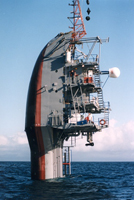 The Navy’s Floating Instrument Platform, better known as FLIP, went into service fifty years ago, in 1962. The 355-foot research vessel is capable of operating horizontally as a conventional, if somewhat odd-looking, ship. When on station, however, it “flips” vertically 90 degrees and becomes the equivalent of a massive spar buoy. Because the hydrodynamic forces act primarily on the bottom of the vessel, which is far below the surface waves, the ship is highly stable in heavy seas and up to 80′ waves.
The Navy’s Floating Instrument Platform, better known as FLIP, went into service fifty years ago, in 1962. The 355-foot research vessel is capable of operating horizontally as a conventional, if somewhat odd-looking, ship. When on station, however, it “flips” vertically 90 degrees and becomes the equivalent of a massive spar buoy. Because the hydrodynamic forces act primarily on the bottom of the vessel, which is far below the surface waves, the ship is highly stable in heavy seas and up to 80′ waves.
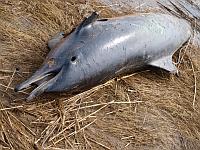 In a previous Environmental Impact Statement (EIS) for 2009-2013, the U.S. Navy estimated that 150,000 marine mammals could be harmed in sonar training and testing exercises. Now in the EIS for 2014-2018, Navy estimates have soared, suggesting that sonar training and testing might unintentionally harm marine mammals 2.8 million times a year over five years, including deafening 15,900 whales and dolphins and killing 1,800 more over the next five years, in testing in Hawaii, off the California and Atlantic Coasts, and in the Gulf of Mexico.
In a previous Environmental Impact Statement (EIS) for 2009-2013, the U.S. Navy estimated that 150,000 marine mammals could be harmed in sonar training and testing exercises. Now in the EIS for 2014-2018, Navy estimates have soared, suggesting that sonar training and testing might unintentionally harm marine mammals 2.8 million times a year over five years, including deafening 15,900 whales and dolphins and killing 1,800 more over the next five years, in testing in Hawaii, off the California and Atlantic Coasts, and in the Gulf of Mexico.
To sign a petition opposing the Navy’s plans, click here. Time is short. All comments are due by July 10, 2012, so please sign the petition today
 Happy 4th of July! Those of us in the United States celebrate the anniversary of the adoption of the Declaration of Independence on July 4th 1776. Immediately after declaring independence from Great Britain, the representatives in the Continental Congress drank a toast with glasses of Madeira wine.
Happy 4th of July! Those of us in the United States celebrate the anniversary of the adoption of the Declaration of Independence on July 4th 1776. Immediately after declaring independence from Great Britain, the representatives in the Continental Congress drank a toast with glasses of Madeira wine.
Why Madiera? It was virtually the only wine available in the American colonies at the time. Wine carried by sailing ship was often spoiled in transit by the constant jostling of the ship and the wide variations of heat and cold. Wine from the island of Madeira, however, was fortified with a small amount of sugar cane brandy to help it survive the ocean voyage. Not only did the fortified wine survive the voyage but it was found that the heat and motion of the ship actually improved the quality of the wine.
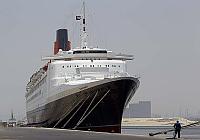 For several years now cruise ships fans have been concerned that the 2008 debt crunch in Dubai would result in the RMS Queen Elizabeth 2 being sold for scrap instead of being converted to a luxury hotel, as had been the plan when she was purchased by Dubai investment company Istithmar for $100 million. On Monday, it was announced that the ship would be converted to a more modest 300 room hotel. Originally a 1,000 room facility had been planned. The ship will also not be moored at Nakheel’s Palm Jumeirah, the emirate’s famous palm-shaped island, but instead would be tied up at the Port Rashid cruise terminal in a commercial district a considerable distance from the more tourist-friendly neighbourhoods. For classic cruise ship fans, the good news is that large portion of the ship will remain unrenovated.
For several years now cruise ships fans have been concerned that the 2008 debt crunch in Dubai would result in the RMS Queen Elizabeth 2 being sold for scrap instead of being converted to a luxury hotel, as had been the plan when she was purchased by Dubai investment company Istithmar for $100 million. On Monday, it was announced that the ship would be converted to a more modest 300 room hotel. Originally a 1,000 room facility had been planned. The ship will also not be moored at Nakheel’s Palm Jumeirah, the emirate’s famous palm-shaped island, but instead would be tied up at the Port Rashid cruise terminal in a commercial district a considerable distance from the more tourist-friendly neighbourhoods. For classic cruise ship fans, the good news is that large portion of the ship will remain unrenovated.
Dubai unveils more modest plans for QE2 hotel
Continue reading
We recently posted about OpSail 2012 and Boston’s weeklong celebration of the USS Constitution and the bicentennial of the War of 1812. The USS Constitution, nicknamed “Old Ironsides” after British round shot bounced off her oak planks, is the world’s oldest commissioned naval vessel afloat. In honor of the grand old ship, here is a wonderful newsreel from the 1950s about USS Constitution.
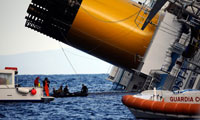 Extremely disturbing news coming out of Italy regarding the Costa Concordia, which ran aground and sank off the island of Giglio on January 13, 2012 with the deaths of at least 30 passengers. If the reports prove to be true, the ship was sailing with open watertight doors, doors which were required to be closed prior to sailing, when she ran aground. There are also reports that the ship’s so called “black box” had not been functioning for days prior to the collision, that this was not the first time that the black box had failed and that the company was aware that the device required repair.
Extremely disturbing news coming out of Italy regarding the Costa Concordia, which ran aground and sank off the island of Giglio on January 13, 2012 with the deaths of at least 30 passengers. If the reports prove to be true, the ship was sailing with open watertight doors, doors which were required to be closed prior to sailing, when she ran aground. There are also reports that the ship’s so called “black box” had not been functioning for days prior to the collision, that this was not the first time that the black box had failed and that the company was aware that the device required repair.
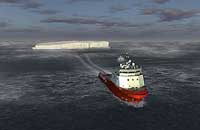 About a year ago, we posted Towing Icebergs – an Idea Whose Time is Still Coming?, where we pointed out that the latest proposal to tow icebergs from the Arctic or Antarctic to supply fresh water, was similar to plans that dated from the late 1970s. We should have gone much father back. Alexis Madrigal, writing in the Atlantic Monthly, describes the various schemes and dreams of moving bergs at least through 1825. Most of these schemes were failures, but not all. My favorite was an apparently successful venture towing small icebergs from southern Chile to Valparaiso to provide refrigeration to local breweries. “Sometimes the icebergs were supplied with sails to utilize the prevailing winds.” Thanks to Phil Leon for pointing out the article.
About a year ago, we posted Towing Icebergs – an Idea Whose Time is Still Coming?, where we pointed out that the latest proposal to tow icebergs from the Arctic or Antarctic to supply fresh water, was similar to plans that dated from the late 1970s. We should have gone much father back. Alexis Madrigal, writing in the Atlantic Monthly, describes the various schemes and dreams of moving bergs at least through 1825. Most of these schemes were failures, but not all. My favorite was an apparently successful venture towing small icebergs from southern Chile to Valparaiso to provide refrigeration to local breweries. “Sometimes the icebergs were supplied with sails to utilize the prevailing winds.” Thanks to Phil Leon for pointing out the article.
The Many Failures and Few Successes of Zany Iceberg Towing Schemes
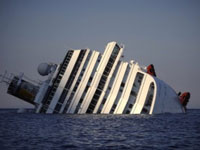 Mississippi lawyer John Arthur Eaves is supposed to be good at his job and is, by reputation, a pretty smart fellow. He recently filed a law suit claiming that the Costa Concordia was “defectively designed,” a ” floating coffin,” had a “propensity … to roll and list” and was dangerous “because of the maze-effect within the vessel…” I am not a lawyer, but as a naval architect, I can say with a fair degree of confidence that Mr. Eaves does not know the first thing about ship stability.
Mississippi lawyer John Arthur Eaves is supposed to be good at his job and is, by reputation, a pretty smart fellow. He recently filed a law suit claiming that the Costa Concordia was “defectively designed,” a ” floating coffin,” had a “propensity … to roll and list” and was dangerous “because of the maze-effect within the vessel…” I am not a lawyer, but as a naval architect, I can say with a fair degree of confidence that Mr. Eaves does not know the first thing about ship stability.
Continue reading
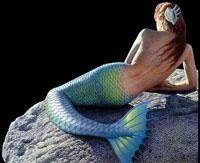 The National Oceanic and Atmospheric Administration has taken the bold step of announcing that “no evidence of aquatic humanoids has ever been found.” In other words, mermaids aren’t real! Something is fishy here. On the other hand, the government has also denied the existence of space aliens, yet how else can one explain Donald Trump?
The National Oceanic and Atmospheric Administration has taken the bold step of announcing that “no evidence of aquatic humanoids has ever been found.” In other words, mermaids aren’t real! Something is fishy here. On the other hand, the government has also denied the existence of space aliens, yet how else can one explain Donald Trump?
All joking aside, why did NOAA, a government agency with presumably better things to do, find it necessary to make such an announcement?
Continue reading
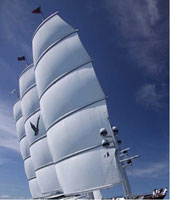 Arthur Sewall, a shipbuilder, shipowner and industrialist from Bath Maine, is quoted near the turn of the 20th century, saying, “As long as the wind blows and water flows there will be sailing ships built and business to keep them busy.” Is the great age of commercial sail now just part of history, or are we merely passing through a short-lived era of fossil fuels, which will be brought to a close by scarcity and concerns about pollution and climate change?
Arthur Sewall, a shipbuilder, shipowner and industrialist from Bath Maine, is quoted near the turn of the 20th century, saying, “As long as the wind blows and water flows there will be sailing ships built and business to keep them busy.” Is the great age of commercial sail now just part of history, or are we merely passing through a short-lived era of fossil fuels, which will be brought to a close by scarcity and concerns about pollution and climate change?
This question was brought to mind by a series of articles last month (see also here and here) about the sailing ship design being developed by B9 Shipping. In many respects the information in the articles is not new. We posted about the B9 Project in October of 2010. Nevertheless, new publicity for the modern sailing ship design is all for the good.
Continue reading
A fascinating short film dating from 1935. From the notes: This film is tricky to describe: is it a boat study, a film-poem, an experiment, a picture postcard? One thing is certain: it’s a rare colour snapshot of the Thames and London in the 1930s – and it looks quite magical.
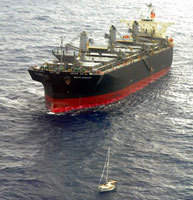 For those in trouble at sea, technology has dramatically increased the chances of survival. Satellite phones, GPS transducers, EPIRBs and the like have made it possible to call for help across the vastness of the world’s oceans. Some things haven’t changed however. When help arrives, chances are, it will be a merchant seafarer who comes to the rescue.
For those in trouble at sea, technology has dramatically increased the chances of survival. Satellite phones, GPS transducers, EPIRBs and the like have made it possible to call for help across the vastness of the world’s oceans. Some things haven’t changed however. When help arrives, chances are, it will be a merchant seafarer who comes to the rescue.
This Wednesday, when a distress call went out from a boat overloaded with asylum seekers bound for Australia’s Christmas Island, the first vessel on the scene was the Bison Express, a cattle carrier. Within a few hours, two other merchant vessels also arrived. Four of the refugees died, but 134 were saved by the crews of the merchant ships.
Continue reading
